In the realm of cryptography, the robustness of a cipher is invariably tied to the complexity of its key space. A playful inquiry arises: can one augment a cipher’s key space to fortify its security? This question is not merely rhetorical; it challenges the very foundations of cipher design and highlights the intricate balance between algorithmic sophistication and key management.
The key space of a cipher refers to the total number of possible keys that can be employed in the encryption process. As the size of this space increases, the effort required for a brute-force attack escalates exponentially. To elucidate, consider a symmetric-key cipher with a key length of n bits. The theoretical maximum number of keys is given by 2n. As one might infer, a mere increase of a few bits can result in an astronomical expansion of potential keys. For instance, transitioning from a 128-bit to a 192-bit key length augments the key space from 2128 to 2192, illustrating the power of logarithmic scaling.
But how does one effectively increase the key space? A common strategy is to deploy longer keys. This, however, is not a panacea. The underlying algorithm must be resilient; a longer key utilized with a frail algorithm does not necessarily guarantee enhanced security. Hence, the cipher’s architecture must be scrutinized. One must evaluate whether the algorithm employs a sufficiently intricate key schedule that ensures that the additional bits contribute meaningfully to security rather than merely extending the key length for superficial effect.
Another avenue for augmenting key space is through the utilization of multiple keys. Multi-key encryption can increase complexity, as different keys can be employed for different segments of the data or different sessions. However, this approach brings forth challenges related to key management and distribution. Handling multiple keys can become unwieldy. If not managed properly, it could lead to vulnerabilities, such as key exposure or loss, thereby nullifying the intended benefits.
Additionally, one must consider the implications of using various ciphers concurrently, known as hybrid encryption systems. These systems leverage the strengths of multiple encryption algorithms, amplifying security through diversity. However, integrating different ciphers introduces new layers of complexity, as their interoperation must be seamless and devoid of weaknesses that could be exploited.
Beyond simply lengthening keys or employing multiple keys, one may propose the integration of dynamic key generation algorithms. These algorithms can create keys on-the-fly, adjusting based on certain parameters such as time, data packets, or usage patterns. Such methodologies bolster the unpredictability of key selection, thwarting potential adversaries who anticipate static key usage. This technique, however, necessitates a robust framework to prevent synchronization issues, which could lead to decryption failures.
A lesser-known approach to increasing key space involves expanding the character set used within a key. Traditional ciphers often utilize a limited set of characters—typically alphanumeric. By incorporating non-alphanumeric symbols, spaces, and even Unicode characters, one can drastically increase the potential combinations within a key, significantly enhancing security. The challenge, nonetheless, lies in the complexity of key handling systems which need to accommodate this wider array.
Furthermore, one must not overlook the human factors in key management. Systems that rely on users to create and remember keys can introduce vulnerabilities due to predictable behavior—many individuals resort to easy-to-remember phrases or reuse key patterns across different platforms. Counteracting these tendencies requires education and the use of secure key storage solutions, which complicates the dilemma of security versus usability.
When assessing how to augment a cipher’s key space for enhanced security, one must also consider computational efficiency. As key lengths increase and key generation methods become more intricate, the demands on computational resources may rise. This can result in throttling performance, particularly in environments where efficiency is paramount, such as embedded systems. Therefore, while expanding key space can yield stronger security, it is imperative to maintain a balance between strength and performance, ensuring that security enhancements do not render the system impractical.
In conclusion, while there is a multiplicity of strategies to expand a cipher’s key space and bolster security, effective implementation is contingent upon a comprehensive understanding of the underlying principles of cryptography. Merely lengthening keys or employing multiple ciphers is insufficient if the core mechanisms are flawed. Moreover, human factors and system efficiencies must be carefully weighed in the balance. Ultimately, the goal is not just to create a cipher with a vast key space but to strategically engineer a robust security framework capable of withstanding the ever-evolving tactics of cyber adversaries.








Leave a Comment